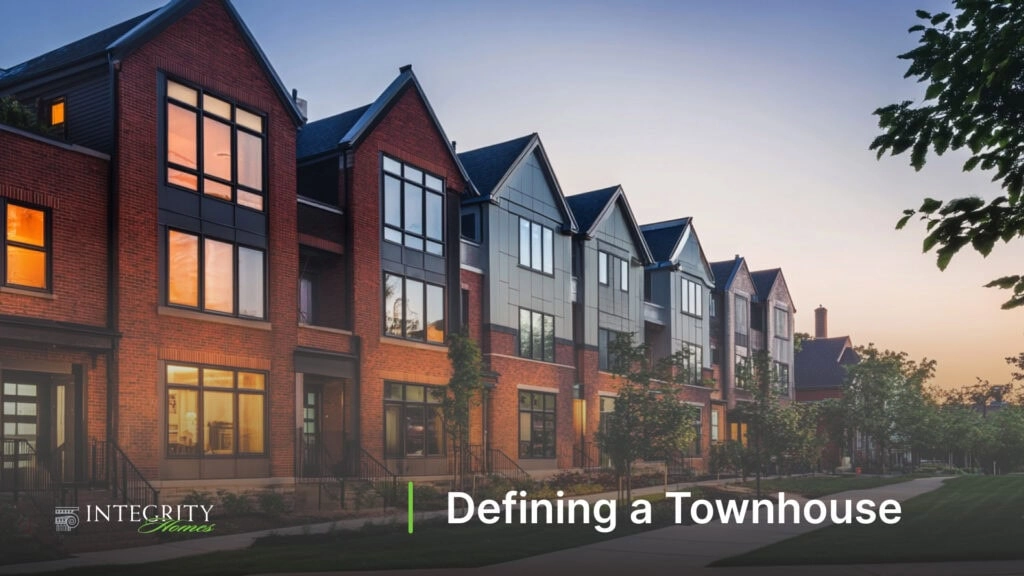
If you’ve ever wondered, ‘is a townhouse a single-family home?’, the short answer is yes, but it’s a bit more nuanced. In essence, townhouses are legally considered single-family homes because they have independent ownership and no shared living spaces with other units. However, they often share exterior walls with adjacent units, unlike traditional single-family homes.

Typically, a townhouse is defined as a residence with multiple floors that usually has one or more shared walls with an adjacent property. Townhouses are classified as single-family homes because they have a ground-to-roof wall that separates each unit. These structures may be individual vertical units or part of a larger complex overseen by a homeowner’s association (HOA). Townhouses are commonly designed to have several levels within a space-efficient layout and include communal walls.
Townhouses strike an appealing balance for homebuyers by offering the privacy and character of a single-family home along with the practical aspects found in multi-family properties and dwellings. They provide efficient utilization of space while still delivering the sense of living in an individual family home. Residents often benefit from being part of a community, complete with access to shared amenities such as swimming pools and recreational areas.

A single family home is an independent structure set aside for the exclusive use of one owner, encompassing both the house and its surrounding land. These properties are distinct in that they do not share utility systems, walls or common areas with adjacent houses. The privacy and self-sufficiency provided by these homes make them perfect for families seeking their own space without interference from others. Defining a single family home highlights its solitary nature and specific ownership setup.
Such residences boast amenities like personal entrances, direct access to streets, and substantial outdoor areas which appeal to those who prioritize individual space and seclusion. Single-family dwellings provide owners with extensive flexibility in terms of modifications and enhancements allowing for personalized adjustments to their living spaces.

Numerous distinctions exist between single-family homes and townhouses, ranging from their architectural design to the nuances of land ownership, as well as disparities in utilities and upkeep requirements. Each element holds potential sway over your choice contingent on individual tastes and long-term aspirations.
The variance between these property types will guide you towards the one that most suitably matches your way of life. Single-family properties offer an enhanced level of seclusion along with a greater amount of space, while townhouses typically necessitate reduced maintenance efforts and contribute to cultivating a more robust community among residents.
Townhouses are distinct from single-family homes in their architectural design, often constructed in series as multiple units. Usually, townhouses have one or more shared walls with neighboring units and sit on smaller parcels of land when compared to the generous land accompanying single-family homes. The size of a typical single family home is around 2,500 square feet. Meanwhile, townhouse sizes span between 1,000 and 3,000 square feet.
Single-family homes come with individual entryways and eschew communal areas, which enhances both privacy and independence for the family residing there. Townhouses on the other hand frequently find themselves nestled within livelier urban locales where they provide easy access to city conveniences.
The differences in ownership and land between single-family homes and townhouses are significant. Owners of townhouses, much like those of single-family homes, usually possess the land on which their unit stands as well as the structure itself. This contrasts with condo owners who typically lack ownership over the land under their units.
Often, townhouse communities come under the purview of homeowners’ associations (HOAs), which oversee shared amenities and general maintenance within these developments. The collective model of property management present in HOAs can influence how much individual autonomy and decision-making power one has relative to owning a stand-alone family home.
Responsibilities for utilities and upkeep vary between single-family properties and townhouses. Owners of single-family homes are typically responsible for all aspects of maintenance, encompassing everything from roofing to landscaping. While this may be seen as a benefit or a drawback, it ultimately depends on the homeowner’s inclination towards personally managing their property.
In contrast, townhouses demand less personal effort in terms of maintenance because external care is usually overseen by homeowners associations. Consequently, maintaining a townhouse can be more cost-effective and involve fewer direct responsibilities than is the case with single family homes that require greater individual involvement.

Townhouses are legally recognized as a type of single family dwelling in the United States, per the Census Bureau’s classification. This designation is based on townhouses being distinct units with walls that extend from the ground to roof level, signifying separate ownership and functioning independently.
Despite their physical connection to other units, townhouses still fall under the category of single-family homes because they feature independent ownership without shared living spaces or common areas. As such, they represent an interesting hybrid between multi-family and single-family residential properties.

Deciding whether to purchase a townhouse or a single-family home requires careful consideration of the advantages and disadvantages linked with each. Townhouses are more affordable and come with the added benefit of communal amenities, drawing in numerous purchasers. Nevertheless, they tend to offer reduced privacy levels due to their design and include governance by Homeowners Association (HOA) rules.
Conversely, opting for a single-family home grants greater space, increased seclusion, and the ability for personal modifications, but usually involves higher expenses along with elevated upkeep duties. Understanding these key trade-offs is essential when making an educated choice about your living situation.
Townhouses typically offer a more budget-friendly alternative to detached single-family homes as they come with shared walls, reducing construction costs and the amount of land required per unit. This cost-efficiency is particularly attractive to first-time homebuyers seeking entry into the housing market.
Shared amenities such as fitness centers, swimming pools, and recreational areas are often features of townhouse communities that contribute to an enriched living environment. These factors combined – affordability, communal facilities, and community atmosphere – make townhouses an attractive option for numerous individuals and families.
Despite their benefits, townhouses come with certain limitations. One of the main drawbacks is a reduced level of privacy owing to having shared walls with neighbors. This close proximity can result in disturbances such as noise from adjacent homes.
Owners of townhouses are often required to adhere to HOA (Homeowners Association) rules which may restrict their freedom to customize and make changes to their properties. Such constraints can be bothersome for individuals who prize independence and personalization in their living environments.
Properties designed for single families typically provide more generous indoor living spaces and extensive outdoor areas, which are perfect for both family needs and individuals who take pleasure in gardening or outdoor recreation.
Single-family properties also afford a higher degree of privacy because they usually sit on individual lots that are spaced farther apart from adjacent homes. This distance grants homeowners greater liberty to personalize and renovate their property as desired.
Nevertheless, owning single-family homes is not without its drawbacks. The expenses associated with these properties are often more substantial than those for townhouses, encompassing both the initial acquisition townhouse cost and ongoing maintenance. Such increased financial demands may weigh heavily on prospective purchasers.
The entire burden of maintaining a property falls squarely on the shoulders of single-family homeowners. This can be an arduous and time-intensive commitment that might not appeal to all individuals, especially those who have demanding schedules or little desire to engage in household upkeep tasks.

Various groups may find townhouses to be a perfect housing option. They are particularly attractive to first-time homebuyers who value their affordability and the reduced need for maintenance they offer. Those living in urban areas might choose townhouses because of their strategic proximity to amenities and public transport facilities.
Those looking for a strong sense of community could be drawn toward townhouse developments that provide communal parks and organized social events. As such, the versatility of townhouse living can accommodate the varied desires and necessities across different demographics.

When choosing between a single-family home and a townhouse, monetary factors play an essential role. Townhouses typically appear more financially accessible, appealing particularly to those purchasing their first property. In comparison, a multi-family property can offer potential rental income, making it an attractive option for investors. Nevertheless, one must consider more than just the initial cost of acquisition.
Our exploration will encompass not only the buying price, but also delve into ongoing financial obligations such as property taxes, monthly mortgage payments, and HOA fees to furnish you with a thorough fiscal comparison for both kinds of residences.
Typically, choosing a townhouse comes with the advantage of reduced upfront expenses when compared to single-family homes. This affordability boost is often due to the cost-sharing aspects such as common walls, roofs, and areas that are maintained collectively, which makes them an attractive option for those purchasing their first home.
On the other hand, although single family houses may require greater financial outlay from the outset, they frequently boast superior potential for appreciation in resale value over time. The property taxes associated with these types of homes tend to be steeper as a result of more extensive land possession and elevated values inherent in detached family residences.
The cost of owning a home and financial strategizing are greatly influenced by monthly mortgage payments. When it comes to townhouses, these payments vary based on the selling price, prevailing interest rates, as well as any HOA fees that might apply.
On the other hand, for single-family homes, mortgage payments are contingent upon the market value of the property and the conditions of the loan. Although townhouse mortgages can sometimes be more affordable because their purchase prices may be less steep, this benefit is often balanced out by additional HOA fees.
Typically, individuals living in a townhouse development are responsible for monthly HOA fees, which go towards the upkeep of common amenities and maintenance services. This expenditure is an important factor to consider when calculating the total cost associated with residing in a townhouse.
The provision of communal features such as swimming pools, gyms, and recreational parks contributes additional value for inhabitants and these conveniences are commonly sustained by the collection of HOA fees. Nevertheless, it’s crucial to account for these fees as part of your financial planning due to their role in increasing the monthly expenses associated with townhouse living.

Deciding whether to opt for a townhouse or a single-family home often depends on financial capability, the desire for convenience, and specific lifestyle requirements. The suitability of each property type is greatly influenced by personal tastes and unique life scenarios.
In essence, your choice should correspond with your way of living and economic means to ensure lasting contentment. Giving importance to factors such as cost-effectiveness, spaciousness, seclusion, or neighborhood facilities is essential in recognizing the distinctions between single-family homes and townhouses, which will guide you toward a decision that’s well-informed.
In summary, choosing between a townhouse and a single family home depends on individual priorities and circumstances. Townhouses often come with the benefits of being more affordable, having access to shared amenities within the community, and requiring less upkeep – attributes that may appeal especially to those buying their first homes or living in city environments. Conversely, opting for a single family home provides additional space, enhanced privacy options, as well as greater liberty to customize your living area. These perks usually accompany increased financial investment and hands-on maintenance tasks.
To arrive at an informed choice best suited for you personally requires weighing your specific desires regarding lifestyle preferences alongside fiscal realities. Whether it’s the communal orientation and convenience of maintenance associated with townhouses or the expansive personal domain inherent in single family homes that resonates more strongly with you will ultimately influence where satisfaction lies in your future residence selection journey – carefully contemplate each aspect’s significance so as to secure an ideal match tailored towards enriching everyday domestic life.
Yes, townhouses can be classified as single-family homes when they are individually owned with no shared living spaces and are separated from one another by walls. The single family home definition generally refers to a standalone residential structure meant for one owner, characterized by no shared walls and standing on its own land, and it pertains to the household structure rather than the number of occupants.
This distinction is important for property ownership and zoning considerations.
Living in a townhouse provides affordability, lower maintenance, and access to shared amenities like pools and parks, making it a practical choice for many individuals and families.
Living in a single-family home often comes with higher purchase and maintenance costs, as well as a significant responsibility for property upkeep.
This can be both time-consuming and demanding for homeowners.
If you are a first-time homebuyer, urban dweller, or family looking for affordability and a sense of community, a townhouse may be a good fit for you.
Their lower maintenance requirements make them an attractive option for these groups.
The overall expenses associated with residing in a townhouse are elevated by HOA fees, which compensate for the upkeep of the property and grant entry to communal amenities like swimming pools and gym facilities.
Such contributions to maintenance can significantly improve both your quality of life and the standard of your community.
Maryland | Frederick, MD | National Harbor, MD | Potomac, MD
Virginia | Alexandria, VA | Fairfax, VA | Lorton, VA | Northern, VA | Stafford, VA | Stephenson, VA | Winchester, VA | Washington DC